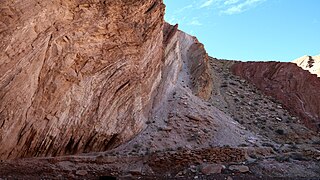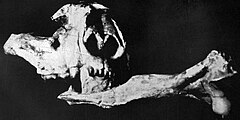
The Eagle Sandstone, originally the Eagle Formation, is a geological formation in Montana whose strata date back to the Late Cretaceous. It is a light to brownish gray to pale yellow-orange, fine-grained sandstone. It contains areas of crossbedding and local shale members. It contains large sandy calcareous concretions. Its thickness varies from 100 to 350 feet due to the lens nature of the individual sandstone layers and local interbedded sandy shale layers.

The Freda Sandstone is a geologic formation in Michigan. It dates back to the Proterozoic. Lithologically, the Freda Sandstone is a lithic, red-brown, cyclic sequence of sandstones, mudstones and shales.

The Hinton Formation is a geologic formation in West Virginia. It preserves fossils dating back to the Carboniferous period. It is mainly made up of limestone, sandstone, and shale.
The Williamsport Sandstone is a sandstone geologic formation in West Virginia, Virginia, Pennsylvania, and Maryland. The formation includes the Cedar Creek Limestone member. Near Cumberland, Maryland it includes the Cedar Creek Limestone member. It preserves fossils dating back to the Silurian period.
The Sylvania Sandstone is a geologic formation in Ohio and Michigan. Its type locality is Sylvania, Ohio. It preserves fossils dating back to the Devonian period.
The Fido Sandstone is a geologic formation in Virginia. It preserves fossils dating back to the Carboniferous period.
The Java Formation is a geologic formation in Kentucky, New York, Ohio, Pennsylvania, Tennessee, Virginia, West Virginia. It preserves fossils dating back to the Devonian period. The formation comprises the Pipe Creek Shale, Wiscoy Sandstone Member in New York, and Hanover Shale Member except in Tennessee.
The Gatesburg Formation is a geologic formation in Pennsylvania. It preserves fossils dating back to the Cambrian period.

The Jordan Sandstone is a geologic formation in Wisconsin. It preserves fossils dating back to the Cambrian period.
The Fall River Sandstone is a geologic formation in Nebraska, United States. It preserves fossils dating back to the Cretaceous period.

The Sheep Creek Formation is a geologic formation in Nebraska. It preserves fossils dating back to the Neogene period.
The Whitehorse Formation is a geologic formation in Nebraska and Oklahoma. It preserves fossils dating back to the Permian period.
The Sawatch Formation is a geologic formation in eastern Colorado. It is a sedimentary sequence formed approximately 530 million years ago during a marine transgression. It preserves fossils dating back to the Cambrian period. It is composed of glauconitic and quartz-rich sandstone.
The Troublesome Formation is a geologic formation in Colorado. It preserves fossils dating back to the Neogene period. It consists of Pale shades of pink, tan, gray, green, and white interbedded siltstone and mudstone, less abundant arkosic sandstone and conglomerate, and sparse limestone and altered crystal-vitric ash and tuff; generally poorly consolidated. It includes atypical deposits containing abundant pink, granitic cobbles and boulders along the western parts of the outcrop in the west-central and southwestern parts of the Granby Quadrangle, Fossil mammals from three sites indicate a late Oligocene age.
The Harding Sandstone is a geologic formation in Colorado. It preserves fossils dating back to the Ordovician period.

The Maroon Formation is a geologic formation in Colorado. It preserves fossils dating back to the Permian period. It is the primary formation of sandstone that lends the vivid red color to the hills around Glenwood Springs, Colorado.

The Horse Spring Formation is a geologic formation in Nevada. It preserves fossils dating back to the Neogene period. The lower unit is conglomerate and the middle and upper are sandstone and freshwater limestone.
The Friars Formation is a geologic formation in San Diego County, Southern California.
The Pocahontas Formation is a coal-bearing geologic formation in West Virginia. It preserves fossils dating back to the Carboniferous period.
The Princeton Sandstone is a geologic formation in West Virginia. It preserves fossils dating back to the Carboniferous period.







